STATEHOUSE REPORT | ISSUE 20.46 | NOV. 12, 2021
BIG STORY: New Swails bio highlights Reconstruction-era Senate leader
NEWS BRIEFS: Hugh Leatherman, powerful Pee Dee senator, passes away
LOWCOUNTRY, Ariail School board meeting
COMMENTARY, Brack: Bad idea to ban books and manufacture outrage
SPOTLIGHT: AT&T
MY TURN, Teague: House, Senate maps differ on competitive districts
FEEDBACK: Guns promoted too loudly
MYSTERY PHOTO: Another white building
New Swails bio highlights Reconstruction-era Senate leader
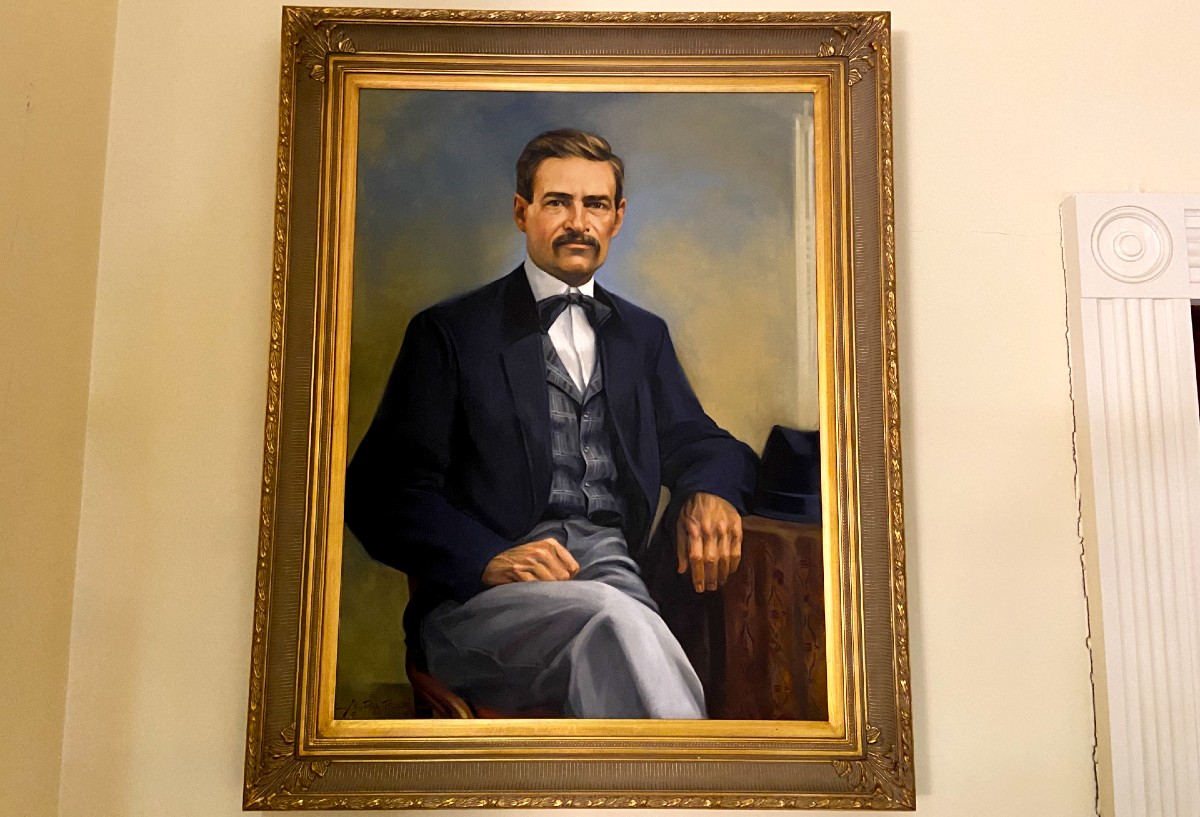
Editor’s Note: This story, originally published in the Charleston City Paper, follows up on a related Oct. 15 story in Statehouse Report, about a portrait now hanging in the Senate chamber.
By Herb Frazier, Charleston City Paper | Four years ago, Civil War historian and Mount Pleasant-based attorney Gordon C. Rhea began an exploration into the life and legacy of a little-known black Civil War hero.
A decade before Rhea’s research of soldier-turn-politician Stephen A. Swails, a private group had commissioned a portrait of Swails for the state South Carolina Senate chamber where he served after the Civil War.
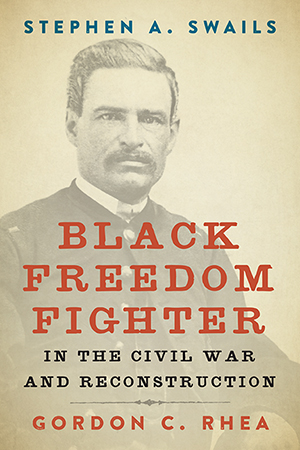
A 13-year wait to place Swails’ portrait in the Senate recently ended when, after questions from a reporter, it was finally taken out of a closet and mounted in the chamber just in time for Rhea’s latest book. This month the Louisiana State University Press is scheduled to release Stephen A. Swails: Black Freedom Fighter in the Civil War and Reconstruction.
From 1868 to 1878, Swails represented Williamsburg County in the Senate, including three terms as president pro tempore. He was an attorney and mayor of Kingstree where he published a newspaper, The Williamsburg Republican.
Swails’ political life followed his service in the U.S. Army that began when he joined the 54th Massachusetts Volunteer Regiment, composed of mostly free Black men from the north who fought against slavery. Swails was with the unit during a bloody battle on Morris Island near Charleston.
Including his upcoming biography of Swails, Rhea has written eight books on the Civil War. He is best known for his award-winning account of the Overland Campaign, a five-book series that tells the story of three massive battles and dozens of skirmishes in Northern Virginia.
Over a vegetarian burrito at Santi’s on Morrison Drive, Rhea talked about his book with the Charleston City Paper.
City Paper: What did Swails do when he left the military?
Gordon Rhea: Swails worked with the Freedmen’s Bureau in the Kingstree area. He won huge support from the Black population and also from a lot of the white population. He was an arbiter between the freedmen and former masters. The Freedmen’s Bureau helped the newly freed population receive an education, get land to farm and live real lives. Swails mediated disputes. He helped former plantation owners come to terms with the fact that they had to deal with people differently than they had in the past. He handled that in a very smart way.
CP: In your research did you see similarities between today and the Reconstruction period when Swails served in the Statehouse.
GR: At the end of the Civil War obviously slavery was dead. But the predominantly white population of South Carolina and many of the other southern states had as a major goal to restore the situation as close as possible to what it was pre-war. Fortunately, there was significant intervention by the U.S. government, which set requirements for new elections to be held in which race was not a factor and a new constitution was drawn. Swails was involved in drawing up the new constitution of South Carolina.
CP: As a seasoned Civil War historian, what surprises did you find during your research of Swails.
GR: I was very familiar with the Civil War battles, but I had never delved into the details of Reconstruction. I was astounded at the level of violence as the white population tried to regain total control. I was surprised to learn that the federal government initially supported the African-American population, but then (the government) got tired of spending that kind of money and backed away. So it led to a total abandonment which in many ways encouraged white supremacists in their fight because now they realized there’ll be no more U.S. marshals or federal troops in the state and no more official Washington support for equal rights. The collapse of Reconstruction led to a violent retribution against the black population that led to Jim Crow and to other inequities, many of which persist today.
CP: Describe the level of violence toward Black people during Reconstruction.
GR: The violence of the 1870s was much more targeted. There were targeted assassinations of black leaders and white leaders who sympathized with blacks in South Carolina. Their purpose was to let the black population know if it didn’t stay in line they could be badly injured or killed.
CP: What were the efforts used during Reconstruction to block the black vote?
GR: The white populace viewed themselves as having lost control of the state because so much of the black population was voting. Controlling the ballot box became critical. One thing that’s going on right now is gerrymandering. That went on big time back in Swails’ days. Basically, the white-controlled Senate at the end of Reconstruction reconfigured judicial districts and put most of the Black people into one district so that all the other districts would be predominantly white.
CP: Any other surprises or lessons learned?
GR: I was surprised how someone like Stephen Swails was able to maneuver through the intricacies of the political process to walk and talk with both sides. He was selected as the speaker pro tempore in the South Carolina Senate and held that position throughout Reconstruction. So he was the top man. He was putting the deals together. He was trying to make things work.
CP: What person today has Swails-like qualities?
GR: I think Congressman James Clyburn has a lot of those same attributes. He knows how to fight for his constituency, but at the same time, he knows the importance of making compromises, making deals that move the ball in the right direction.
- Have a comment? Send to: feedback@statehousereport.com.
Hugh Leatherman, powerful Pee Dee senator, passes away

Staff reports | S.C. Sen. Hugh Leatherman, the powerful Florence Republican who chaired the Senate Finance Committee, died at home early today after a long battle with cancer. About three weeks ago following surgery for abdominal pain, an aggressive cancer was found. He then started receiving hospice care at home.
“Colleagues described him as among the last of the Senate’s old guard statesmen, who strove to keep debates civil and collegial as he remained focused on proposals he thought would bring jobs to South Carolina and help the working class,” The Post and Courier reported. “He could be an unflinching advocate or hard-nosed foe, though his stances were rarely rooted in partisan politics.”
Leatherman, 90, started his political career as a Democrat when first elected to the legislature in 1981. He later switched parties and for years chaired the Senate Finance Committee, one of two legislative committees that controls the state’s purse strings.
Through the years, Leatherman helped to direct state spending, economic development projects and infrastructure deals. Examples include luring Boeing to the state to make jets and greatly improving infrastructure at the S.C. State Ports Authority, where a new port terminal is named for him in North Charleston.
Leatherman worked with both parties, often in a pivotal peacemaking role, to hammer out deals in the Senate and with the House of Representatives.
“I’m actually glad he did switch parties, because if he had not, somebody else would have been in that position as chairman of Finance, other than Hugh Leatherman,” state Democratic Sen. Darrell Jackson of Columbia said. “And I’m not sure that would have worked out as well for South Carolina.”
The Senate’s current president, Sen. Harvey Peeler, R-Cherokee, is next in line to chair the Senate Finance Committee.
In other recent news:
![]() House redistricting plan ruffles feathers. While the Senate’s redistricting plan advanced out of committee with ease, the House’s plan has drawn bipartisan criticism that it discouraged competition, divided communities of interest, and did not allow sufficient time for informed public comment. More: The Post and Courier | AP News.
House redistricting plan ruffles feathers. While the Senate’s redistricting plan advanced out of committee with ease, the House’s plan has drawn bipartisan criticism that it discouraged competition, divided communities of interest, and did not allow sufficient time for informed public comment. More: The Post and Courier | AP News.
Bond denied again for prominent attorney Murdaugh. Alex Murdaugh will likely remain in jail for many months while awaiting trial on charges of insurance fraud connected to the death of a housekeeper. Murdaugh’s wife and son were found shot to death at their family estate earlier this year, and Murdaugh is facing multiple cases claiming he stole from his law firm, stole insurance money from the heirs of a dead housekeeper, and sought to defraud insurance by trying to have an acquaintance shoot and kill him.
S.C. lawmaker looks at Texas-style abortion law. S.C. Sen. Larry Grooms, R-Berkeley, has called a controversial Texas abortion law, which allows private citizens to sue abortion providers, “a very novel approach,” hinting at a possible S.C. adaptation. More: The State.
S.C. School Boards Association pulls from national group. The South Carolina School Boards Association officially cut ties with its national counterpart on Nov. 8 after a controversial letter calling for federal authorities to deal with aggression and intimidation at school board meetings. More: The Post and Courier.
S.C. economy didn’t slow as state sees $1 billion surplus. The amount of money in South Carolina’s state bank accounts continues to grow thanks to a quick recovery from the economic shock of the COVID-19 pandemic and people spending money much faster than experts predicted. Previously reported in Statehouse Report.
State’s murder, assault rates rise. South Carolina’s murder rate increased by more than 52 percent in the last five years, according to new state crime numbers. The report highlights that statewide murders increased from 452 in 2019 to 552 in 2020. “The report also noted 2020 brought the highest aggravated assault rate since 2011. It said 42.8 of every 10,000 S.C. residents in 2020 were victims of aggravated assault, as opposed to 45.8 in 2011.” More: The State | WYFF.
SC for Ed survey finds ‘potentially broken’ school system. A survey released by teacher advocacy group SC for Ed says public school staffing woes have been known for years and yet few actions have been made. The survey found that 38 percent of teachers planned to leave their current positions. In a related report in Charleston County, responses to a survey from 853 educators in the Charleston County School District detail a bleak education experience on both sides of the teacher’s desk.
- Want more headlines every business day that are like this? Visit our friends at SC Clips.
School board meeting
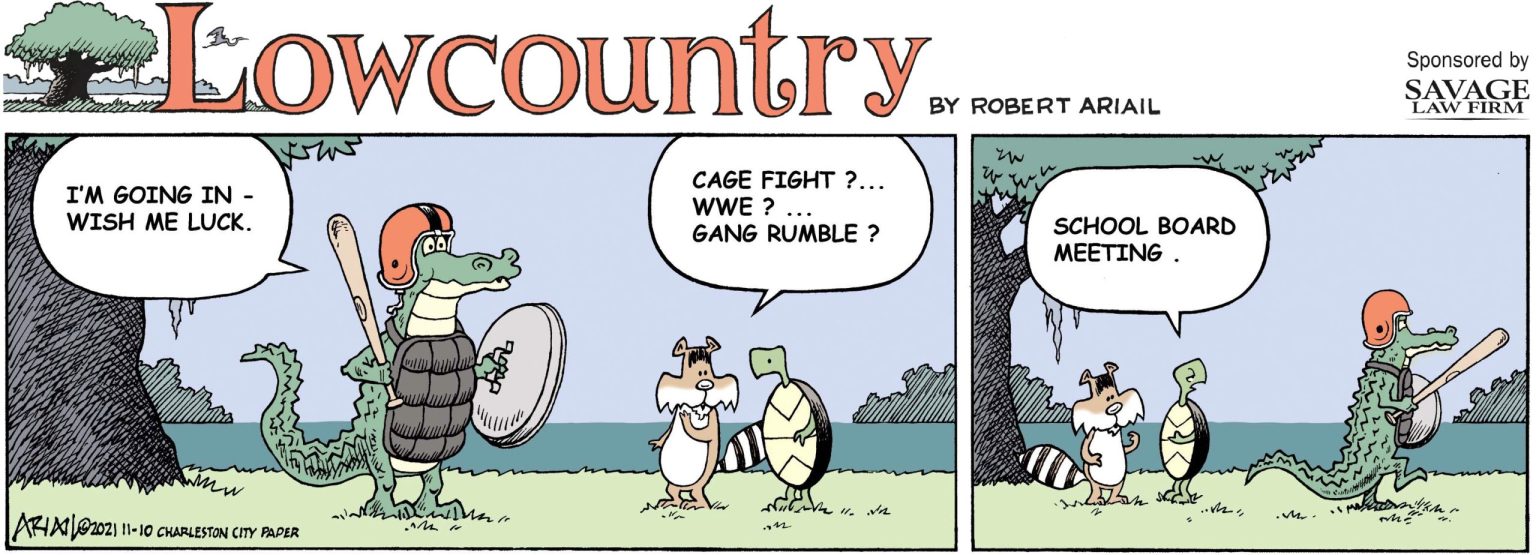
Cartoonist Robert Ariail always has an interesting take on what’s going on in South Carolina. His weekly “Lowcountry” strip is originally drawn for our sister publication, the Charleston City Paper. Love the cartoon? Hate it? What do you think: feedback@statehousereport.com.
Bad idea to ban books and manufacture outrage

By Andy Brack, editor and publisher | With the 2022 political season right around the corner, it’s wholly predictable that it’s time for some kind of manufactured moral outrage by a Republican candidate to whip the troops in line.
 This has been going on by both sides for years, as noted years ago by critic H.L. Mencken: “The whole aim of practical politics is to keep the populace alarmed (and hence clamorous to be led to safety) by menacing it with an endless series of hobgoblins, all of them imaginary.”
This has been going on by both sides for years, as noted years ago by critic H.L. Mencken: “The whole aim of practical politics is to keep the populace alarmed (and hence clamorous to be led to safety) by menacing it with an endless series of hobgoblins, all of them imaginary.”
This week, Gov. Henry McMaster called for an immediate investigation at all of the state’s public schools into whether they had “obscene and pornographic materials.” He also ordered state police to probe whether any state laws had been broken.
Seems some parents in Fort Mill complained about a book titled Gender Queer: A Memoir, written by award-winning new author Maia Kobabe. The State newspaper reported the book is an autobiography “about how Kobabe dealt with being nonbinary while growing up.” But according to McMaster, it includes “sexually explicit and pornographic depictions which easily meet or exceed the statutory definition of obscenity.” That’s remarkably similar to what conservatives in other states have been saying for more than a month as they railed to get the book banned.
 A reality check: By drawing attention to the book in the age of Amazon, the author probably now will sell more books here in little old South Carolina. Why? Because people — high school students, in particular — don’t like being told what to do. And if they can’t get a book in one place, they’ll find it some other place, including paying $16 to get it delivered.
A reality check: By drawing attention to the book in the age of Amazon, the author probably now will sell more books here in little old South Carolina. Why? Because people — high school students, in particular — don’t like being told what to do. And if they can’t get a book in one place, they’ll find it some other place, including paying $16 to get it delivered.
A cynic might ask, “So what’s really going on here?” Let’s look at the political map. In a few months, the Republican Party will have its primary. On the ballot, again, will be McMaster, who counts on Christian conservatives as a big base of support. Meanwhile, it’s likely an Upstate challenger will emerge. So what’s a veteran candidate to do? Whip up a moral crisis to reacquaint Upstate voters with his moral fiber.
It’s not inconceivable McMaster’s political handlers have been lying in wait for just the right book, movie, speech, snub or slip of the tongue to use politically to energize base supporters. When they learned about Kobabe’s book being banned by a Virginia county school board and later challenged at schools in several states, they sprang.
While McMaster and supporters might get all hot and bothered about the issue, it’s never a good idea to ban a book. Trying to get rid of printed words and cartoons doesn’t get rid of ideas. You might not like what someone says, but what if someone wants to get rid of the words you use and write? Wouldn’t you cry, “Freedom of speech?”
Furthermore, banning a book or stomping on an idea you don’t like is in your frame of reference. It doesn’t take into account the perspective of others. The audience for the book isn’t the devout Christian in Greenville, but perhaps someone living in that home who is questioning God, religion, gender or something else.
Listen to what Kobabe wrote in an Oct. 29 opinion piece in The Washington Post: “Queer youth are often forced to look outside their own homes, and outside the education system, to find information on who they are. Removing or restricting queer books in libraries and schools is like cutting a lifeline for queer youth, who might not yet even know what terms to ask Google to find out more about their own identities, bodies and health.”
Let’s engage in politics over real ideas that make real differences in people’s lives — better education, better health care, improved roads, a cleaner South Carolina, more jobs, less poverty. Let’s not keep riding the downward spiral of moral outrage, fear and divisiveness.
P.S. Gender Queer is a “#1 Best Seller” right now on Amazon. Go figure.
- Have a comment? Send to: feedback@statehousereport.com.
AT&T
 The public spiritedness of our underwriters allows us to bring Statehouse Report to you at no cost. Today’s featured underwriter is AT&T Inc.
The public spiritedness of our underwriters allows us to bring Statehouse Report to you at no cost. Today’s featured underwriter is AT&T Inc.
AT&T Inc. (NYSE:T) helps millions around the globe connect with leading entertainment, mobile, high speed Internet and voice services. We’re the world’s largest provider of pay TV. We have TV customers in the U.S. and 11 Latin American countries. We offer the best global coverage of any U.S. wireless provider*. And we help businesses worldwide serve their customers better with our mobility and highly secure cloud solutions.
- Additional information about AT&T products and services is available at http://about.att.com.
- Follow our news on Twitter at @ATT, on Facebook at http://www.facebook.com/att and YouTube at http://www.youtube.com/att.
* Global coverage claim based on offering discounted voice and data roaming; LTE roaming; voice roaming; and world-capable smartphone and tablets in more countries than any other U.S. based carrier. International service required. Coverage not available in all areas. Coverage may vary per country and be limited/restricted in some countries.
House, Senate maps differ on competitive districts
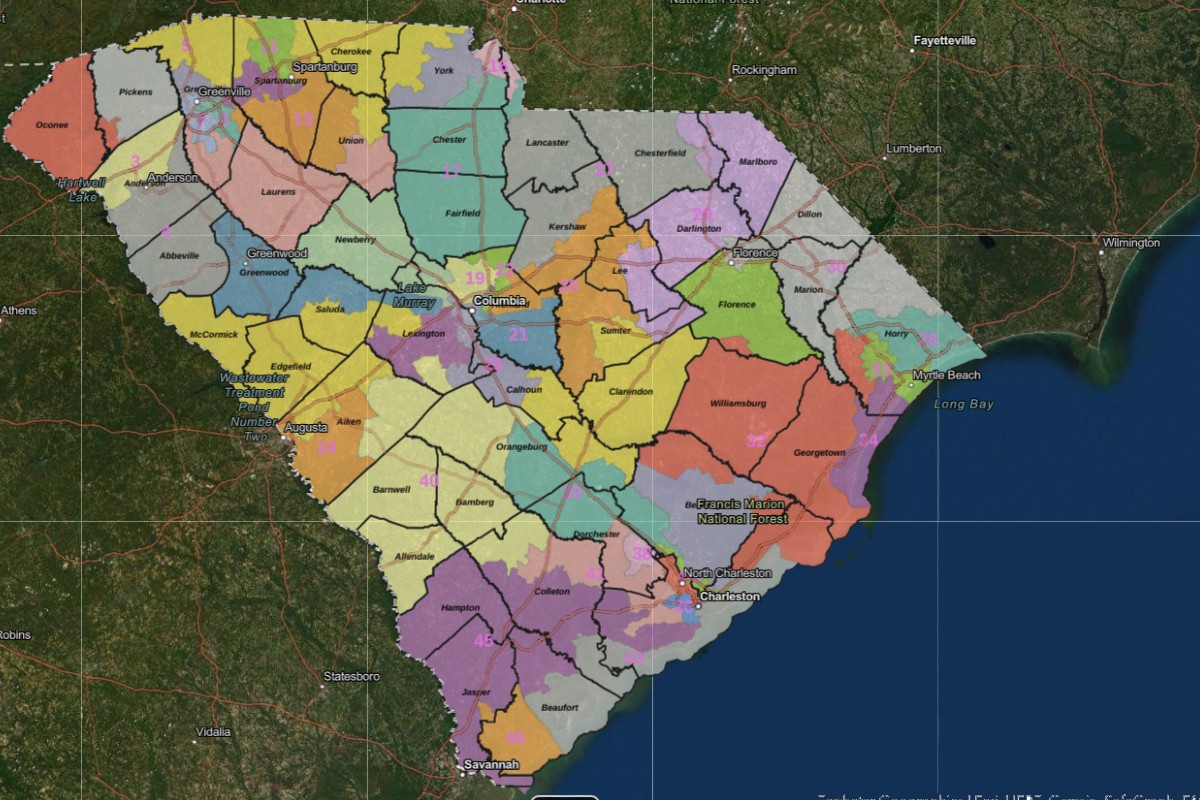
By Lynn S. Teague, League of Women Voters | The process of redrawing South Carolina’s legislative maps kicked into gear with the Aug. 12 release of U. S. Census data. Since then, there have been public hearings, committee meetings, public map submissions and much more.
 Now three months later, the Senate has released its staff proposal for Senate districts and the House has released its draft plan for House districts. Both have a long way to go (through Judiciary committees and floor votes and the governor’s signature) before they are final.
Now three months later, the Senate has released its staff proposal for Senate districts and the House has released its draft plan for House districts. Both have a long way to go (through Judiciary committees and floor votes and the governor’s signature) before they are final.
Any redistricting map must respond to the changing population of our state. There is very rapid growth in the suburbs south of Charlotte and even greater growth along the coast, especially in Horry County, but also in and around Charleston. Other areas increased in population but not so quickly. Finally, the Interstate 95 corridor has lost population. This has many implications, but for purposes of redistricting, it means that political power shifts with population.
How this is handled is important to all of us. There are strategies for map drawing that are focused on the interests of the residents of our state, and others that are focused on the interests of legislators. The League’s own maps and its assessment of other plans are based on the belief that the interests of constituents, not legislators, should prevail.
Senate map reveals little gerrymandering bias
From that perspective, the initial Senate proposal has much to recommend it. The Senate map provides as many competitive districts as does the League map. Very few precincts are split, a practice that is sometimes needed but is too often related to cherry-picking voters to engineer a district for a candidate or party. The Senate plan also reduces expected average election margins below those in current districts, suggesting that district homogeneity has not been inflated to produce forbiddingly large “safe” margins for incumbents. Finally, sophisticated mathematical tests for gerrymandering do not reveal evidence of significant bias.
There are other variables to consider. Keeping communities of interest and political subdivisions together are important. In the Senate plan, some cities have been made whole. Spartanburg, for example, would cease to be divided among three senators. Mount Pleasant is not so fortunate.
Our greatest concern about the Senate map relates to its handling of the changing landscape of the Lowcountry. With its current population, District 39 may continue to provide minorities an opportunity to elect a candidate of their choice, but it is drawn with a relatively low 39 percent Black Voting Age Population (BVAP). That could change quickly. The district includes areas in Berkeley County, including Nexton, Carnes Crossroads and Cane Bay, where population growth is both rapid and very different in character from the rural core of the rest of the district.
Broader concerns about House map
League concerns about the map proposed by the House Redistricting Committee are broader. We recognize that the population in our state is not evenly distributed so that many districts will not be competitive in general elections. However based on our data, the draft House map produces only 12 districts in which the partisan lean margin is plus-or-minus 5 percent, which is considered competitive. This is four districts fewer than in the current map and seven districts fewer than in the League proposal. Noncompetitive districts deprive citizens of a meaningful vote. Legislators have picked their voters, leaving nothing meaningful for the voters to do at the polls in November. With more than 41,000 persons in each House district, seven non-competitive districts add up to more than a quarter million extra South Carolina residents whose representation is decided by legislators, not voters.
This map also fails to respect genuine and important communities of interest. James Island, for example, is thoroughly fragmented. The districts that converge there are oddly configured, for example with District 110 linking one James Island fragment with part of Mount Pleasant. The map submitted by the League shows that it is possible to map this area with more compact districts and with greater adherence to political subdivisions and communities of interest.
Finally, analysis using widely accepted redistricting mathematical evaluation methods shows that the House map displays extreme bias. Of about one billion maps that were simulated, only 1,410 were more extreme than the House proposal. This contrasts with a far greater 83,777,304 maps in the simulation that are more extreme than the League proposal. The map submitted by the League of Women Voters can be considered a benchmark for what can be expected as a product of the underlying demographics of our state. We find that there is a painfully wide gap between the naturally occurring effects of population distributions in the League map and the extreme bias of the House plan.
The League encourages everyone who is interested to visit www.lwvsc.org where we post a wide range of redistricting information and updates. Having done that, tell your House and Senate members what you hope for when they shape our politics for the decade to come.
Columbia resident Lynn Teague is vice president for issues and action for the League of Women Voters of South Carolina. Have a comment? Send to: feedback@statehousereport.com.
Guns promoted too loudly
To the editor:
![]() Thank you for publishing your commentary. I have always abhorred the TV ads that this gun shop uses and thought surely there must be some actual FCC regulations against such promotion. Their manner of advertising preys on the public as much as advertising for payday loans.
Thank you for publishing your commentary. I have always abhorred the TV ads that this gun shop uses and thought surely there must be some actual FCC regulations against such promotion. Their manner of advertising preys on the public as much as advertising for payday loans.
Why are guns being promoted so loudly here in the Charleston area where gun violence with stolen and illegal guns is more common daily ? Methinks it is something more than making a profit!
— Freida McDuffie, Charleston, S.C.
Send us your thoughts
We receive a few comments a week and look forward to publishing. But often we can’t because we can’t verify the identity of the writer. To be published, you’ve got to provide us with contact information so we can verify your letters. Verified letters to the editor are published weekly. We reserve the right to edit for length and clarity. Comments are limited to 250 words or less. Please include your name and contact information.
- Send your letters or comments to: feedback@statehousereport.com
Another white building
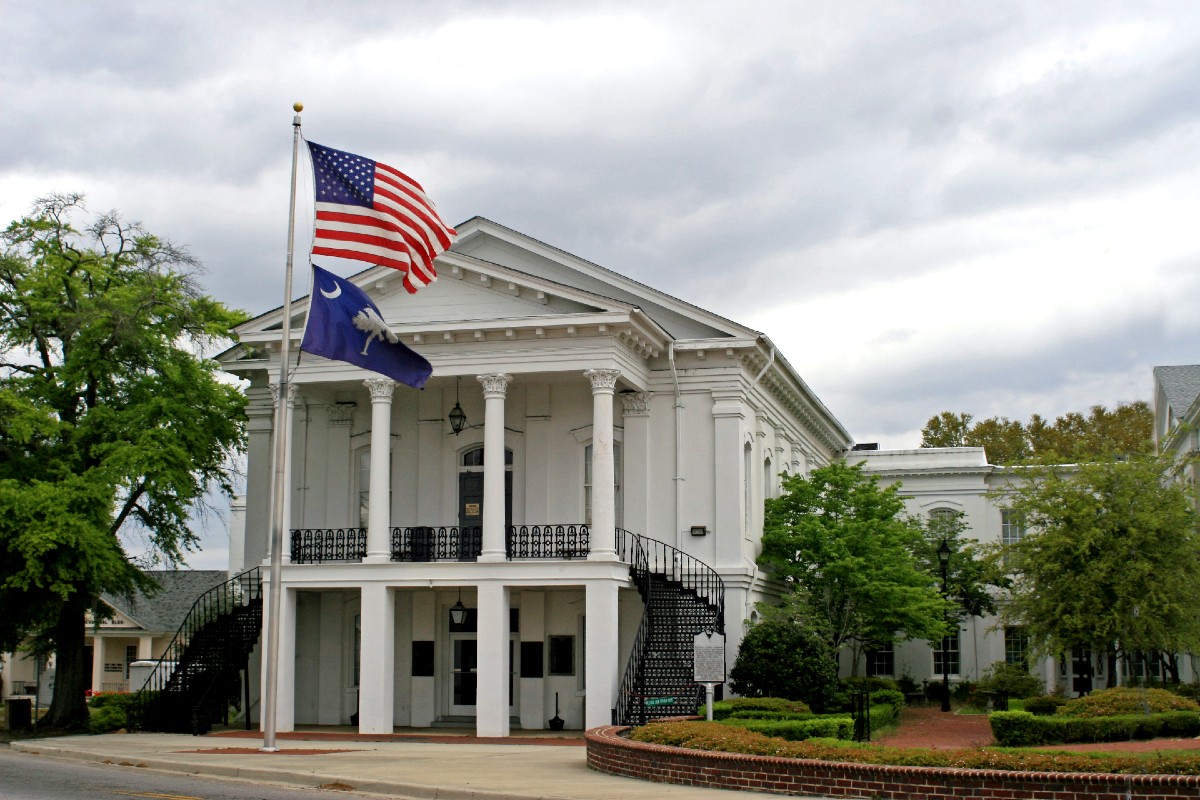
Here’s another white building in South Carolina to identify. Send your guess to feedback@statehousereport.com — and remember to include your name, home city and contact information.
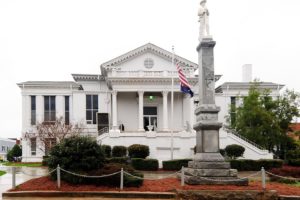 Last week’s mystery, “White building,” showed a photo of the Laurens County Courthouse.
Last week’s mystery, “White building,” showed a photo of the Laurens County Courthouse.
Congratulations to readers who identified it: Steve Willis of Lancaster; Kevin Mertens of Greenville; Jacie Godfrey and Barry Wingard, both of Florence; Bill Segars of Hartsville; George Graf of Palmyra, Va.; Elizabeth Jones and Jay Altman, both of Columbia; Allan Peel of San Antonio, Texas; and Frank Bouknight of Summerville.
Segars shared that the photo was “of the 1838 Laurens County Courthouse. The original Greek Revival building was designed by Thomas C. Veal and built by Dr. John Wells Simpson. A 1911 addition was designed by Anthony Ten Eyck Brown, Luther D. Proffitt and Martin Luther Hampton.”
Peel added, “The Confederate statue that is visible in the mystery photo was erected “In Memory of The Boys in Gray” in 1910 by the Citizens of Laurens County and the Joseph Brevard Kershaw Chapter, U.D.C. Some additional historical information, background, and historic photos of this site can be viewed here.”
Lupo shared that the Library of Congress includes this photo (1890-1910) of a crowd in front of the courthouse.
- Send us a mystery. If you have a photo that you believe will stump readers, send it along (but make sure to tell us what it is because it may stump us too!) Send to: feedback@statehousereport.com and mark it as a photo submission. Thanks.
ORDER NOW: Copies are in Lowcountry-area bookstores now, but if you can’t swing by, you can order a copy online today.
ABOUT STATEHOUSE REPORT
Statehouse Report, founded in 2001 as a weekly legislative forecast that informs readers about what is going to happen in South Carolina politics and policy, is provided to you at no charge every Friday.
- Editor and publisher: Andy Brack, 843.670.3996
Donate today
We’re proud to offer Statehouse Report for free. For more than a dozen years, we’ve been the go-to place for insightful independent policy and political news and views in the Palmetto State. And we love it as much as you do.
But now, we can use your help. If you’ve been thinking of contributing to Statehouse Report over the years, now would be a great time to contribute as we deal with the crisis. In advance, thank you.
Buy the book
Now you can get a copy of editor and publisher Andy Brack’s We Can Do Better, South Carolina! ($14.99) as a paperback or as a Kindle book ($7.99). . The book of essays offers incisive commentaries by editor and publisher Andy Brack on the American South, the common good, vexing problems for the Palmetto State and interesting South Carolina leaders.
More
- Mailing address: Send inquiries by mail to: P.O. Box 21942, Charleston, SC 29413
- Subscriptions are free: Click to subscribe.
- We hope you’ll keep receiving the great news and information from Statehouse Report, but if you need to unsubscribe, go to the bottom of the weekly email issue and follow the instructions.
- Read our sister publications: Charleston City Paper (every Wednesday) | Charleston Currents (every Monday).
- © 2021, Statehouse Report, a publication of City Paper Publishing, LLC. All rights reserved.
















 We Can Do Better, South Carolina!
We Can Do Better, South Carolina!